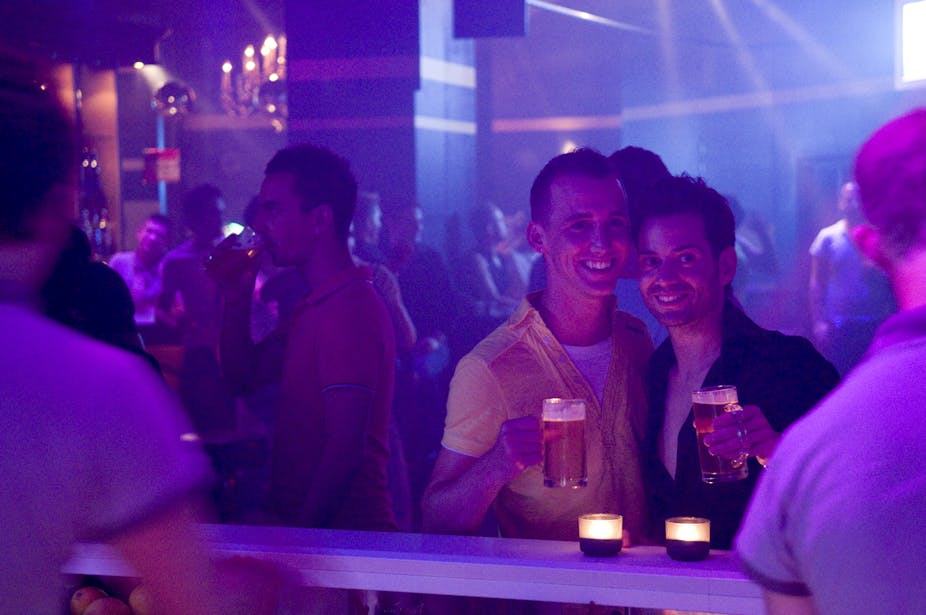Australia’s legal system may not yet reflect this but in 2014, according to a range of polls, a majority of Australians support same-sex marriage. Two decades ago, such support would have been beyond the imaginings of all but the most wildly optimistic gay or lesbian person. After all, it was not until 1997 that Tasmania decriminalised male-to-male sexual intercourse.

Today, homophobia still exists but it is no longer as institutionalised or as entrenched as it once was. The pace at which social attitudes towards gay and lesbian Australians have evolved over the past two decades has been dizzying. It is perhaps the most rapid transformation of social attitudes that has occurred in Australian history.
Australian Lesbian and Gay Life Stories, a national oral history project currently underway, seeks to explore this transformation further. The project is a collaboration between the National Library of Australia, Macquarie University and two other Australian universities, supported by funding from the Australian Research Council.
Different generations of gay and lesbian individuals will provide insight into what it has been like to live a gay or lesbian life in Australia from the 1940s to the present, when attitudes have shifted so remarkably.
Telling the stories of ordinary Australians
The project will interview five different generations of “ordinary” gay men and lesbians providing deep insight into how individuals negotiate social change in their intimate lives. This project is the first comprehensive nationwide oral history project undertaken with a diverse range of members of Australia’s lesbian and gay population.

Interviewers are travelling across Australia, from locations ranging from cattle stations to inner-city apartments, to conduct interviews. The results will then be deposited with the National Library of Australia, home of Australia’s largest collection of oral histories.
The National Library has pioneered public engagement with oral history in this country, taking advantage of significant advantages in the field of digital technologies and participatory online media. Interviewees control access conditions but some have agreed to make their interviews publicly available through the National Library’s website.

The central aims of this project are twofold.
First, it will bolster and diversify the National Library of Australia’s digital collection by providing up to 300 hours of lesbian and gay oral histories.
Second, it will obtain primary information from a still marginalised community, allowing for the incorporation of this material into the national narrative.
More broadly, the project will investigate how lesbian and gay individuals have navigated a period of extraordinary social change, and the impact of this transformation on lesbian and gay lives and cultural narratives.
Researchers on this project acknowledge the important gay and lesbian oral histories that have previously been conducted by other researchers, including the ongoing efforts of the Australian Lesbian and Gay Archives in Melbourne. But there are some limitations with existing interviews that point to the need for a project such as this one. Some existing interviews are not broadly accessible, remaining in the possession of individual researchers or local repositories.

Community repositories generally do not possess the substantial funding required to support large-scale projects and their preservation. A large proportion of existing oral history interviews have been recorded on tape. Many have poor sound quality, have degraded over time and do not meet national or international technological standards for oral history.
Furthermore, the bulk of existing oral histories have focused on activists within the gay and lesbian community, rather than “ordinary” Australians.
Whose stories will be told?
Interviews for the Australian Lesbian and Gay Life Stories project are being conducted with participants born between 1930 and 1994 who self-identify as same-sex attracted. Participants are being divided into five generational cohorts, a method that has proven to be highly successful in the Australian Generations: Life Histories, Generational Change and Australian Memory collaboration being led by Professor Alistair Thomson from Monash University.
Cohorts on the Australian Lesbian and Gay Life Stories project include:
- respondents born before 1940, who reached sexual maturity at a time when male-to-male homosexuality was illegal and was aggressively policed
- respondents born between 1941 and 1956, who came of age during the 1960s and during the rapid social change of the 1970s
- respondents born between 1957 and 1966, who were young when the gay liberation movement emerged in Australia
- respondents born between 1967 and 1984, who came of age during and in the aftermath of the HIV/AIDS epidemic
- those born after 1985, many of whom feel they live in a “post gay” era where ideas about the meaning of gay and lesbian identity are shifting.
Australian Lesbian and Gay Life Stories is an Australian first and will make an important addition to the National Library’s collection. It will provide a resource equivalent to the Before Stonewall: A Lesbian, Gay, Bisexual and Transgendered Oral History collection, held by the British Library Sound Archive Collection. Unlike Before Stonewall, much of this Australian resource will be available online, thereby increasing availability and transcending national boundaries.
It will serve to foster broader awareness of lesbian and gay lives – and the ways in which generations of lesbian and gay Australians have shaped a profound transformation of social attitudes in Australia.

